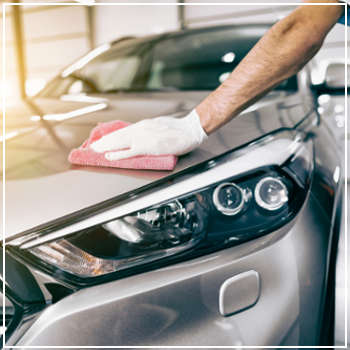 While a DIY paint touchup or car wax can be convenient, the results are not always the best. Specifically with paint, you could be dealing with adhesion issues or a gritty, textured appearance if you’re not careful. Due to the quality of work and available products, professional detailing services like waxing keep your car protected from the elements and looking great.
While a DIY paint touchup or car wax can be convenient, the results are not always the best. Specifically with paint, you could be dealing with adhesion issues or a gritty, textured appearance if you’re not careful. Due to the quality of work and available products, professional detailing services like waxing keep your car protected from the elements and looking great.
Why Wax Your Car and How Often?
Waxing is key to maintaining your car’s exterior appearance. The barrier it creates blocks out various environmental contaminants, like UV rays, tree sap, bird droppings and road debris, and defends against rust.
Waxing also ensures rain beads off the surface and keeps the paint looking fresh. Without regular wax jobs, it begins to develop a dull, faded appearance over time.
To keep the coating fresh, you should aim to have the car waxed every three months on average.
As many drivers know, especially if you live in extremely cold or warm conditions, environmental factors play a role. By default, your car ends up going through more wear and tear than if you lived somewhere more temperate. With this aspect in mind, you may need more than four wax treatments a year if:
- Your car spends part of the year in colder conditions, where it drives over salt-covered roads.
- Pollution in your area is higher than average.
- You park your car under a tree, where it’s regularly exposed to tree sap and bird droppings.
- You park your car directly outdoors every day, where it’s exposed to the elements.
Additionally, inspect your car’s exterior every 45 days to see if the wax is wearing away. Wax type plays a key role in terms of longevity: Natural, carnauba-based waxes have a shorter lifespan than synthetic solutions, some of which are designed to last an entire year.
During a professional appointment, your car will be washed and dried. Its wheels will be cleaned of debris and grease, as well as the trunk seals, windows and door jambs. After all debris is removed and the paint polished, a wax treatment and sealant will be applied to the surface.
When to Get Your Car Professionally Waxed
Professional waxing provides quality and comprehensiveness unmatched by DIY projects. Consider scheduling an appointment with DaSilva’s Auto Body in the following circumstances.
Your Car No Longer Passes the Bead Test
This test is relatively simple: Throw or spray water on your car’s surface. If the wax is strong enough and doing its job, the moisture forms defined beads that roll off the surface. On the other hand, if the water appears to form “sheets” or “streaks,” the wax has worn away.
You Spot Dry Paint
By this stage, UV rays have attacked the paint, especially if you notice cracks in the finish. Not only is the wax completely gone, but the clear coat is not doing its job and the moisture within the paint has started to evaporate.
You Hear a Squeaking Sound
To examine the car’s surface, some people recommend folding a towel until it fits into the palm of your hand and using it to apply pressure to the car’s exterior. As you exert force and move the towel in a circular motion, if you hear a squeaking or squealing noise, the wax has thinned out too far. Ideally, the towel should smoothly move around without noise, even with force applied.
You Spot Scratches
Although paint application may result in light, subtle imperfections, waxing tends to mute and make them seem less conspicuous. As a result, if you notice these usual marks becoming more prominent, the wax has started to wear away and needs to either be touched up in spots or reapplied.
For complete detailing or rust protection, let DaSilva’s Auto Body protect your car from the elements. To schedule a professional wax application or full exterior detailing, contact our Naugatuck shop today.




